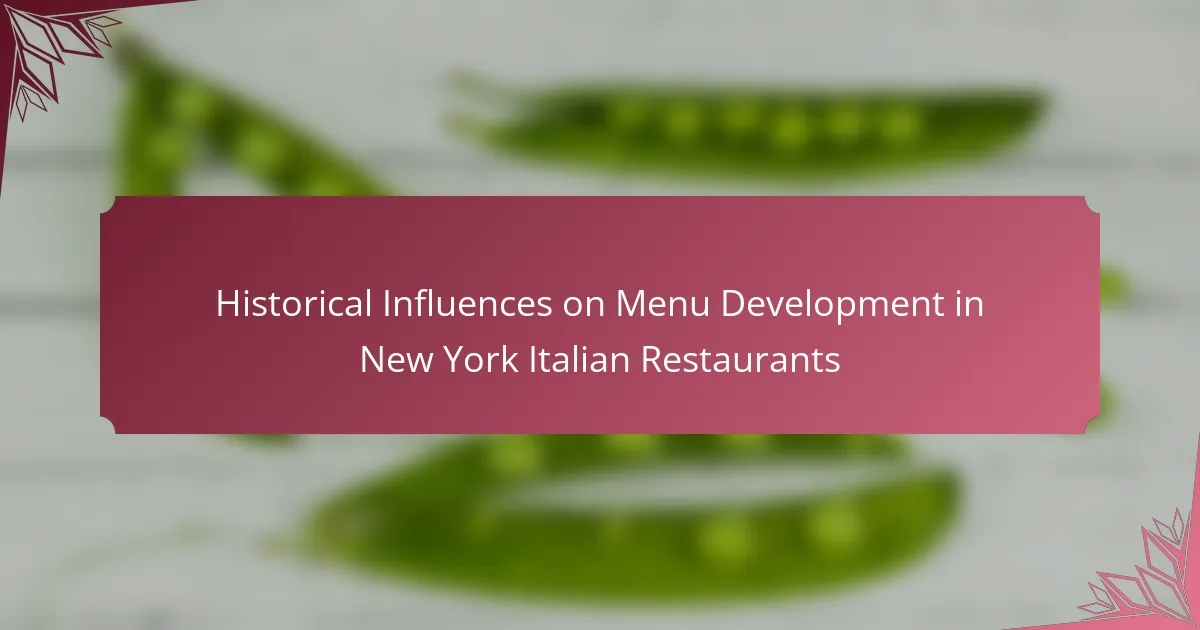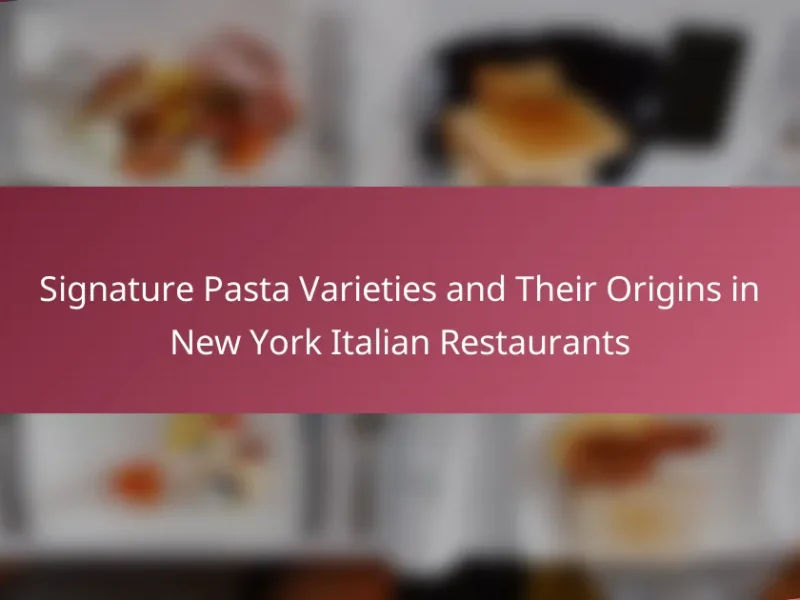The article explores the historical influences on menu development in New York Italian restaurants, focusing on the impact of Italian immigration patterns from the late 19th to early 20th centuries. It details how Italian immigrants introduced regional recipes and culinary traditions, which evolved into Italian-American cuisine, including adaptations like spaghetti and meatballs. The article further examines how events such as Prohibition and the post-World War II era shaped menu offerings, leading to increased popularity and diversification of Italian dining options. Today, New York Italian restaurants represent a fusion of traditional Italian dishes and American culinary influences, reflecting ongoing cultural integration and changing consumer preferences.

What are the Historical Influences on Menu Development in New York Italian Restaurants?
Historical influences on menu development in New York Italian restaurants stem from Italian immigration patterns. The late 19th and early 20th centuries saw a significant influx of Italian immigrants. These immigrants brought regional recipes and culinary traditions from various parts of Italy. Over time, these dishes evolved to suit local tastes and available ingredients.
The introduction of Italian-American cuisine emerged during this period. It featured adaptations like spaghetti and meatballs, which were not traditionally Italian. Prohibition in the 1920s also influenced menu offerings, as many restaurants began to serve more substantial meals to attract patrons.
The post-World War II era saw further changes. Returning soldiers developed a taste for Italian food, leading to increased popularity. The rise of the suburban population in the 1950s expanded the market for Italian restaurants. This growth resulted in a diversification of menu items, catering to a broader audience.
Today, New York Italian restaurants reflect a blend of traditional Italian dishes and American influences. This evolution showcases the dynamic nature of culinary practices in response to cultural integration and consumer preferences.
How did immigration patterns shape the menu offerings?
Immigration patterns significantly shaped menu offerings in New York Italian restaurants. The influx of Italian immigrants in the late 19th and early 20th centuries introduced diverse regional Italian cuisines. These immigrants brought traditional recipes and cooking techniques from various regions of Italy. Dishes like pasta, pizza, and risotto became staples on menus due to their popularity among immigrants.
As these communities settled, they adapted their food to local ingredients and tastes. This led to the creation of hybrid dishes, merging Italian flavors with American culinary practices. For example, the introduction of marinara sauce and meatballs was influenced by American preferences.
Additionally, the economic circumstances of immigrants affected menu offerings. Many sought affordable, filling meals, which led to the popularity of dishes like spaghetti and meatballs. This trend was documented in historical accounts of Italian-American cuisine. Thus, immigration patterns directly influenced the variety and evolution of menu offerings in New York Italian restaurants.
What specific Italian regions influenced New York Italian cuisine?
The specific Italian regions that influenced New York Italian cuisine include Sicily, Campania, and Calabria. Sicilian cuisine introduced dishes like arancini and caponata. Campania contributed pizza, particularly Neapolitan-style pizza. Calabria is known for its spicy flavors and ingredients, such as ‘nduja. These regions brought their traditional recipes and cooking techniques to New York. Immigrants from these areas settled in New York during the late 19th and early 20th centuries. Their culinary traditions shaped the Italian food landscape in the city. The blend of these regional influences created a unique New York Italian cuisine.
How did the arrival of Italian immigrants impact ingredient availability?
The arrival of Italian immigrants significantly increased ingredient availability in New York. They introduced a variety of traditional Italian ingredients to the local market. Items such as pasta, olive oil, and cheeses became more accessible. This influx catered to both Italian communities and the broader population. Italian immigrants established markets and shops specializing in these ingredients. Their culinary practices influenced local grocery offerings. Consequently, New Yorkers gained exposure to diverse flavors and cooking methods. This transformation laid the groundwork for the evolution of Italian cuisine in the region.
What role did cultural assimilation play in menu evolution?
Cultural assimilation significantly influenced menu evolution in New York Italian restaurants. As immigrants integrated into American society, they adapted their traditional recipes. This adaptation often involved using locally available ingredients. The fusion of Italian culinary practices with American tastes led to new dishes. For instance, the introduction of pizza and pasta dishes became mainstream. Additionally, menus began to reflect regional variations, showcasing diverse Italian-American identities. Historical events, such as the Great Migration, accelerated this evolution. Consequently, cultural assimilation shaped the dining experiences and expectations of patrons in these establishments.
How did Italian-American identity influence dish creation?
Italian-American identity significantly influenced dish creation by blending traditional Italian recipes with American ingredients and tastes. This fusion resulted in unique dishes that reflect both cultures. For example, the use of tomato sauce became prevalent, adapting to American preferences for rich flavors. Additionally, the introduction of larger portion sizes catered to American dining habits. The popularity of pizza in the United States showcases this identity shift, evolving from Neapolitan styles to include diverse toppings. Italian-American communities also emphasized comfort food, leading to the creation of dishes like lasagna and meatballs, which became staples in many households. These adaptations illustrate how Italian-American identity shaped the culinary landscape, creating a distinct cuisine that resonates with both heritage and modern American dining.
What adaptations were made to traditional recipes for American tastes?
Traditional recipes were adapted for American tastes by altering ingredients and preparation methods. For example, sauces became sweeter and richer to appeal to American palates. Cheese usage increased, often incorporating mozzarella and Parmesan in larger quantities. Dishes were also modified for larger portion sizes, catering to American dining habits. Spices were toned down, as many traditional Italian spices were considered too strong for American consumers. Additionally, certain ingredients were replaced with more accessible options, such as using ground beef instead of veal. These adaptations reflect the blending of Italian culinary traditions with American preferences, creating a unique dining experience.
How have historical events shaped current menu trends?
Historical events have significantly shaped current menu trends in New York Italian restaurants. The arrival of Italian immigrants in the late 19th and early 20th centuries introduced traditional Italian dishes. These immigrants adapted their recipes to local ingredients, creating a unique fusion of flavors. The Prohibition era in the 1920s led to the rise of speakeasies, where Italian cuisine gained popularity as part of the social scene. Post-World War II, the increase in Italian-American communities further influenced menu offerings. The 1970s saw a shift towards more authentic regional Italian dishes, reflecting a growing interest in culinary diversity. Today, menus often feature a blend of traditional and contemporary dishes, showcasing historical influences while catering to modern tastes.
What impact did World War II have on Italian restaurant menus?
World War II significantly altered Italian restaurant menus in New York. The war led to ingredient shortages and rationing, affecting food availability. Many Italian restaurants adapted by simplifying their menus. Chefs focused on using local and seasonal ingredients. Traditional dishes were modified or replaced with more accessible options. The influence of American cuisine increased during this time. Italian-American dishes became more popular, reflecting a blend of cultures. This shift helped Italian restaurants to survive during challenging economic conditions.
How did the rise of food movements affect Italian cuisine in New York?
The rise of food movements significantly transformed Italian cuisine in New York. These movements emphasized local, organic, and sustainable ingredients. As a result, Italian restaurants began to incorporate seasonal produce into their dishes. Traditional recipes were adapted to reflect modern culinary trends. Chefs started to focus on authenticity and regional variations of Italian cuisine. This shift led to a greater appreciation for artisanal products, such as handmade pasta and locally sourced cheeses. The farm-to-table approach gained popularity among diners seeking quality and transparency in their food. Consequently, Italian cuisine in New York became more diverse and innovative, reflecting both heritage and contemporary values.
What are the connections between historical influences and modern menu development?
Historical influences significantly shape modern menu development in New York Italian restaurants. Traditional Italian cuisine, rooted in regional ingredients and cooking techniques, informs contemporary menu items. Immigrant experiences introduced diverse flavors and dishes, which are now staples in these restaurants. The evolution of food trends, such as farm-to-table and fusion cuisine, reflects historical culinary practices. Additionally, cultural events and societal changes drive menu adaptations to meet consumer preferences. For instance, the rise of health consciousness has led to the inclusion of lighter, vegetarian options. Historical recipes often serve as inspiration for modern interpretations, showcasing a blend of tradition and innovation. This connection between past and present ensures that menus remain relevant while honoring their heritage.
How do regional variations in New York reflect historical influences?
Regional variations in New York reflect historical influences through distinct culinary practices and ingredient preferences. For example, the Italian community in Little Italy emphasizes traditional recipes brought by early immigrants from Southern Italy. This area showcases dishes like pasta and pizza, which align with the historical migration patterns of Italian settlers. In contrast, Brooklyn’s Italian restaurants often incorporate influences from Eastern European cuisine due to the diverse immigrant population in the borough. Historical events, such as the Great Migration, shaped the food landscape by introducing new ingredients and cooking styles. Additionally, upstate New York’s Italian cuisine reflects agricultural practices influenced by local farming, resulting in a focus on fresh produce and artisanal products. These regional variations highlight how historical migration and settlement patterns have shaped the culinary identity of New York’s Italian restaurants.
What unique dishes have emerged from specific neighborhoods?
Unique dishes have emerged from specific neighborhoods in New York, reflecting cultural influences. For example, in Little Italy, the classic dish of spaghetti and meatballs became popular among Italian immigrants. In the Bronx, the dish known as “Pasta alla Vodka” gained prominence in local eateries. Williamsburg is known for its inventive takes on traditional Italian dishes, such as pizza with unique toppings. Each neighborhood’s culinary offerings showcase the historical migration patterns and cultural integration of Italian cuisine in New York.
How do current trends honor or diverge from historical practices?
Current trends in New York Italian restaurants often honor historical practices while also diverging in significant ways. Traditional Italian cuisine emphasized regional ingredients and family recipes. Many contemporary restaurants maintain this focus on authenticity and quality ingredients. However, modern trends incorporate fusion elements and innovative cooking techniques. This divergence reflects a broader culinary landscape that embraces experimentation. For instance, the use of non-traditional ingredients, such as quinoa or avocado, contrasts with historical recipes. Additionally, the rise of plant-based options marks a shift from classic meat-centric dishes. These trends illustrate a blend of respect for heritage and adaptation to contemporary tastes.
What best practices can restaurants adopt to honor historical influences in their menus?
Restaurants can honor historical influences in their menus by incorporating traditional recipes and ingredients. Utilizing local, authentic products reflects regional heritage. Highlighting historical cooking techniques can enhance the dining experience. Offering dishes that tell a story connects patrons to the past. Collaborating with local historians or culinary experts adds depth to menu descriptions. Featuring seasonal ingredients respects historical food practices. Hosting themed events can celebrate specific cultural influences. Educating staff about the menu’s historical context enriches customer interactions. These practices not only preserve culinary traditions but also attract diners interested in cultural experiences.
The main entity of the article is the historical influences on menu development in New York Italian restaurants. The article examines how Italian immigration patterns in the late 19th and early 20th centuries introduced regional recipes and culinary traditions, leading to the evolution of Italian-American cuisine. It highlights the impact of historical events, such as Prohibition and World War II, on menu offerings, as well as the adaptation of traditional recipes to cater to American tastes. Additionally, the article explores the connections between historical influences and modern menu trends, showcasing how regional variations and cultural assimilation have shaped the culinary landscape of Italian restaurants in New York.


